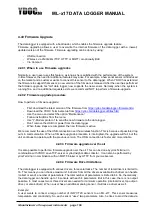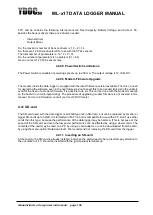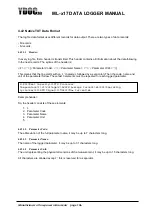
ML-x17 DATA LOGGER MANUAL
Manufacturers of low power instruments
page 118
4.46.1.2
Driver Settings
The following members can be included in a driver settings object:
•
“id”
a “string” to identify the concerned driver by its name in the current active configuration.
•
“dn”
a “string” of max 31 tokens providing the new driver name.
•
“ni”
a number providing the driver initiation interval in seconds.
ni
can’t be any arbitrary value, it
should be in
discrete divisors of 60 seconds, 60 minutes or 24 hours (e.g. “ni”:11 is invalid, while
“ni”:12 is not. If the driver is concerning input(sensors) the interval should be equal or in discrete
divisors of the data log interval. If the driver is concerning outputs (e.g. modem) the interval
should be equal or in multiples of the data log interval. Specifying 0 will make the interval equal to
the normal data log interval.
•
“ai”
a number providing the driver initiation alarm interval in seconds.
ai
can’t be longer than
ni
and
should be in discrete divisors of
ni
(e.g. “ai”:1700 is invalid when “ni”:3600 is provided).
Specifying 0 will make
ai
equal to
ni
.
•
“wu”
a number
providing the “warm-up” time in seconds of the connected device, this is the time
needed by the external device to provide stable service after applying power.
4.46.1.3
Parameter Settings
The following members can be included in a parameter settings object:
•
“id”
a “string” to identify the concerned parameter by its code in the current active configuration.
•
“pc”
a “string” of max 7 tokens providing the new parameter code.
•
“pn”
a “string” of max 23 tokens providing the new parameter name.
•
“pu”
a “string” of max 15 tokens providing the new parameter unit.
•
“nd”
an integer up to 6 to specify the number of decimals to display.
•
“vf”
a number providing a multiplication factor to the raw input value.
•
“vo”
a number providing an offset to add to the input value.
•
“iv”
initial value of the parameter if not sampled yet after a re-start.
•
“ll”
a number providing the low-low alarm limit.
•
“lo”
a number providing the low alarm limit.
•
“hi”
a number providing the high alarm limit.
•
“hh”
a number providing the high-high alarm limit.
•
“ad”
an integer up to 4 specifying how many consecutive samples should be violating limits
before an alarm situation is set.
•
“ah”
a number providing the hysteresis before an alarm situation will be reset.






























